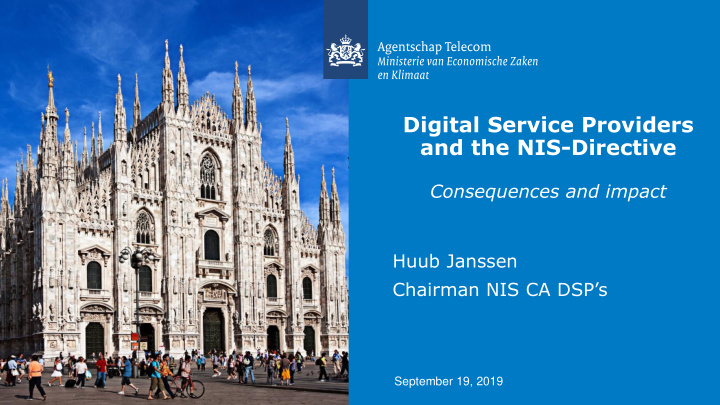



Digital Service Providers and the NIS-Directive Consequences and impact Huub Janssen Chairman NIS CA DSP’s September 19, 2019
Topics 1. NIS Directive 2. Who is a DSP? 3. Consequences? 2
NIS Directive 1. Purpose 2. Issues 3. OES 4. DSP 3
1. NIS Directive › Purpose NIS Directive – Network and Information Systems crucial for society – Incidents are increasing (amount, impact, complexity) – Incidents could cause major effect on EU economy – Focus Operator of Essential Services (OES) ▪ Digital Service Providers (DSP) ▪ – OES/DSP’s should ensure the security of the network and information systems – Need for risk assessment and implementation of security measurements – Measurements should be proportionate to the risk presented 4
1. NIS Directive EU NIS COOPERATION GROUP WORKSTREAMS WS 5: DSP’s MEMBER STATES Implementing in national legislation ENISA Appointing OES CSIRT’s SPOCs Competent Authorities 5
2. Issues ‘security of network and information systems’ means: • the ability of network and information systems to • resist, at a given level of confidence, any action that compromises • the availability, authenticity, integrity or confidentiality • of stored or transmitted or processed data or the related services offered by, or accessible via, those network and information systems 6
3. Operators of Essential Services › Appointed by Member States › In following sectors: – Energy – Transport – Banking – Financial market infrastructures – Health sector – Drinking water – Digital infrastructure › National supervision and regulation 7
4. Digital Service Providers (DSP’s) › DSP by definition › Three types of DSP’s : Online marketplace Cloudcomputing services Online Search engine 8
Who is DSP? 1. Online marketplace 2. Online search engine 3. Cloud service provider 4. SME exception 9
1. Online Marketplace – allows consumers and traders to conclude online sales or service contracts with traders, and is the final destination for the conclusion of those contracts. – B2C and B2B – Characteristics: ▪ Direct online sales of services and goods ▪ Three parties involved ▪ No intermediate sites or services ▪ Processes (personal) data, transactions 10
Examples market places Business to Consumer Business to Business Retail-platforms Food and flower auctions Sharing economy Financial and insurance platforms (fintech) Software/app shops Advertising and profiling Medicine Commodity trading (e.g. oil, gas, electricity) Cryptocurrency brokers Resourcing, recruitment, staffing (employees) Travel/holiday websites (Food) delivery services Sexual services Darkweb platform 11
2. Online search engine – allows the user to perform searches of, in principle, all websites on the basis of a query on any subject 12
3. Cloud computing services – allow access to a scalable and elastic pool of shareable computing resources. – Those computing resources include resources such as networks, servers or other infrastructure, storage, applications and services. – SAAS, PAAS, IAAS 13
4. Exception Small and Micro Enterprises Is your company a DSP under NIS-D? Is my company a: - Online marketplace or No - Online search engine or - Cloud serviceprovider ? Yes Are there more then 50 employees working at the Yes company Your company is not a No DSP under the NIS-D Does the totale balance sheet or yearly revenues No exceed €10 million? Your company is a DSP Yes under the NIS Directive If your company is owned >25% by an other company then numbers should be accumulated. 14
Consequences 1. Security measures 2. Incident reporting 3. Competent authorities 15
1. Security measures › “Digital Service Providers identify and take appropriate and proportionate technical and organisational measures to manage the risks posed to the security of network and information systems” › Measures include: a) the security of systems and facilities b) incident handling c) business continuity management d) monitoring, auditing and testing e) compliance with international standards 16
Risk Analysis To identify risks and determine appropriate and proportionate: – Perform systematic assessments and analysis – Risk-based approach – Identify specific risks and quantify their significance – Including: management of network and information systems ▪ the physical and environmental security ▪ the security of supplies ▪ the access controls ▪ 17
ENISA guidelines https://www.enisa.europa.eu/publications/guidelines-on-assessing-dsp-security-and-oes- compliance-with-the-nisd-security-requirements 18
2. Incident reporting › Substantial incidents must be reported › In the Member State of the main establishment › Incidents are at least substantial in case – Service unavailable more then 5 million user hours – Affecting more than 100 000 users – Created a risk to public safety, public security or of loss of life – Damage to at least one user of over € 1.000.000 19
3. Competent Authorities › Supervision is reactive (not pro active) › Based on incident reporting of other signals › DSP’s need to proof that they are compliant 20
Incident reporting in Italy › Ministry of Economic Development – High Institute for communications and information technology (ISCTI) › Incidents must be reported to: notifica.nis@csirt-ita.it › More information: https://www.csirt-ita.it/ 21
Questions NIS Directive : https://eur-lex.europa.eu/legal- content/EN/TXT/?uri=uriserv:OJ.L_.2016.194.01.0001.01.ENG&toc =OJ:L:2016:194:TOC Implementation Regulation DSP’s : https://eur-lex.europa.eu/legal- content/NL/TXT/?uri=CELEX:32018R0151 Huub Janssen huub.janssen@agentschaptelecom.nl +31629044045 22
Discussion 1. Opportunities and threats 2. Impact of NIS on – Fintech? – Smart mobility? – Smart city? – eHealth? 23
Recommend
More recommend